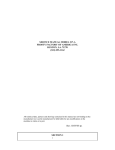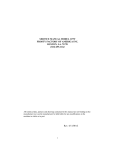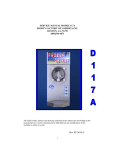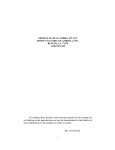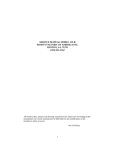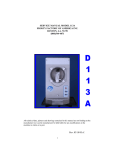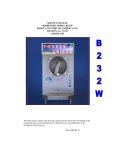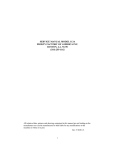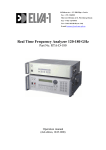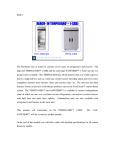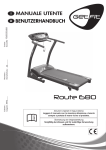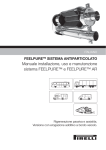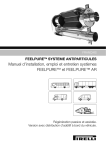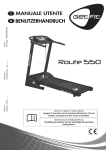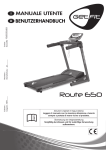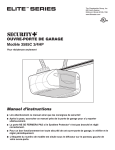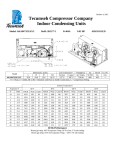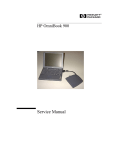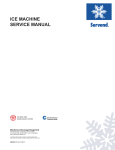Download Frosty Factory 127 Service Manual
Transcript
SERVICE MANUAL MODEL 127A FROSTY FACTORY OF AMERICA INC. RUSTON, LA. 71270 (318) 255-1162 All technical data, pictures and drawings contained in this manual are not binding on the manufacturer nor can the manufacturer be held liable for any modifications to the machine in whole or in part. Rev. 6/14/01 rf. 1 SECTION 1 INTRODUCTION 1.1 USE OF THIS MANUAL Your service manual has been prepared as a guide to help you get the most from your Petite Sorbeteer. It contains information about the installation and operation of your machine. The manual also contains instructions for service and care. The manual should be read carefully by the operator of the Petite Sorbeteer to become familiar with the machine and the correct operating procedures described within. The following notations are used throughout the manual to bring important facts to your attention: “Warning” - This notation is used whenever the personal safety of the operator(s) might be jeopardized, if procedures are not followed correctly. “Caution” - This notation is used whenever the machine or related equipment may receive or cause damage if not observed. “Note” This notation is used to bring important information to your attention that will enhance the performance of your machine. 1.2 PRELIMINARY INSPECTION Unpack the unit as soon as possible upon its arrival. Check the entire machine and its contents for possible shipping damage. Note damage, if any, and notify your carrier immediately. Frosty Factory of America cannot be responsible for damaged merchandise caused by shipping. Inventory the accessories to be sure they include the items you specified on your order. Normally the accessories include: ___ ___ ___ ___ ___ ___ ___ ___ ___ ___ ___ Beater Bar Drip Tray Faceplate Faceplate Knobs “Goody” Bag Hopper Cover Petro-Gel Sanitizer Spare Faucet O-Rings Warranty Card Wire Brush 2 1.3 DESCRIPTION The Petite Sorbeteer is manufactured with a high quality stainless steel cabinet which houses a restaurant grade stainless steel hopper and cylinder which is attached to a sturdy, powder-coated, hand-crafted steel frame. The hopper and cylinder are joined by a feed hole to allow gravity flow operation. The drive motor is mounted within the frame and rotates the beater bar counter clockwise (as viewed from the front of the machine). Panels are stainless steel with plastic louvered inserts to allow maximum airflow for cooling. The stainless steel beater bar assembly is held in place by a clear plastic faceplate, which in turn is held onto the face of the machine with four attractive knobs. Four adjustable legs are installed for leveling. Mix dispensing is provided for via a specially designed “drip-free”, automatic closing faucet assembly. 1.4 SPECIFICATIONS Freezing Cylinder One, 7½ quart (7.2 liter) capacity. Mix Hopper One, 16 quart (15.4 liter) capacity. Refrigeration Unit Internally mounted condensing unit. Compressor: ¾ H.P. 6600 BTU/Hr. Refrigerant: R404 Suction Pressure: 40 psi Beater Motor One, 1/10 hp. Motor * Specifications subject to change without notice Electrical Standard is 115V/60Hz/1Ph. 12.0 amps Power cord - 15 amps Optional is 230V/60Hz/1Ph. 6.0 amps Power cord - 20 amps Dimensions Width: 12” (30.5 cm) Depth: 25 ¾” (65.4 cm) Height: 24.5” (61 cm) Floor Clearance: 4” (10 cm) Approximate Weights Net: 135 lbs. (61.4 kg) Crated: 150 lbs. (68.3 kg) Volume: 13.0 cu. Ft. This unit is designed and constructed to meet stringent safety and sanitation requirements. 3 SECTION 2 LOCATION & INSTALLATION 2.1 SAFETY PRECAUTIONS Do not attempt to operate your Petite Sorbeteer until the safety precautions and operating instructions in this manual are read completely and are thoroughly understood. Take notice of all warning labels on your Petite Sorbeteer. The labels have been put there to inform and protect persons operating and servicing your equipment. Care must be taken not to damage or destroy labels during installation and servicing. The labels have been designed to withstand routine cleaning and handling. Damaged or missing labels should be promptly replaced with approved labels from Frosty Factory of America Inc. 2.2 INSTALLATION Placing your Petite Sorbeteer in a highly visible area will enhance sales. A suitable station will be able to support 200 pounds and will have a dedicated electrical outlet. CAUTION: Do not attempt to share the dedicated electrical outlet with any other appliance, this will cause the circuit breaker to trip. 1. Uncrate your Petite Sorbeteer. 2. The Petite Sorbeteer must be placed on a sturdy platform able to hold the weight of the machine when full of product. Level the machine by turning the adjustable part of the leg. The machine must be level front to back as well as left to right. 3. The Petite Sorbeteer Model 127A is equipped with an air cooled condenser. Air intake is from underneath the Model 127A and discharges through the sides; adequate clearance must be provided on all sides. At least 8” on the sides and 4” under the unit and 6” clearance above the unit. NOTE: Locating the unit in direct sunlight, near cooking facilities or any high heat area will reduce the performance of your machine. CAUTION: Extended operations under severe heat condition can damage the cooling system. NOTE: Establishments that serve beverages from frozen drink machines are responsible for providing the necessary facilities for cleaning and sanitizing their food service equipment. 4. Place the three-position switch in the OFF position (center). 5. Connect the power cord. The Petite Sorbeteer must be connected to a properly grounded receptacle. The electrical cord furnished as part of the Petite Sorbeteer has a three prong grounding type plug. The use of an extension cord is not recommended. If one must be used, refer to the national and local electrical codes. Do not use an adapter to get around grounding requirements. WARNING; Do not attempt to alter the electrical plug. Serious injury or electrocution may result. 6. Install the drip tray, cover, beater bar and faceplate assemblies on the Petite Sorbeteer. 4 SECTION 3 OPERATION 3.1 MACHINE CONTROLS Two selector switches located on the front of the machine control operation of the Petite Sorbeteer. Selection of the right (snowflake) position with the upper (three-position) switch as well as the lower (twoposition) switch will schedule the machine for normal operation. The compressor cycle is managed by a current monitor, which will start the compressor cycle shortly after normal operation is initiated. The red fill light located above the switches will illuminate when the level of mix is low in the hopper. A thermostat knob is visible on the switch bracket of your machine. This is set at the factory and should not be changed except by a qualified technician. Refer to the chart below for functions available with various combinations of switch positions. Top Switch , H Normal Operation - Machine will freeze mix to provide frozen beverage. NOTE: Bottom switch must also be in the snowflake position. (The faceplate must be installed for the motor to run) Top Switch , H Cleaning Operation - The drive motor will run in the faucet position to allow a stirring action of the rinse water while cleaning. No freezing or cooling available in this position. (The faceplate must be installed for the motor to run) Top Switch , Off - The hand symbol is the recognized international symbol for “stop”. In this position, the machine will not run. H Bottom Switch Cooling Operation - Machine will automatically come on whenever necessary to keep mix cooled to (5º C) 40º F. This function is used primarily for overnight storage of the mix remaining in the machine. NOTE: Top switch must be in the snowflake position. H 3.2 THE PRODUC 5 3.2 THE PRODUCT YOU SERVE The Petite Sorbeteer will produce a fine grain, semi-frozen slush when the proper mix is used. When measured with a refractometer, the proper mix will measure 12 to 18 “brix”. Too little sugar in the mix will cause larger ice crystals to form. Too much sugar will lengthen the freeze time. CAUTION: Any attempt to freeze water only will cause severe damage to your machine. NOTE: Do not add sugar directly into the machine, as some of it will settle and result in an improper mix. FRUIT JUICES with at least 32 grams of sugar per 8-oz. serving will freeze well in the Petite Sorbeteer. They will remain stable during the freezing process while retaining their natural color and flavor. NEUTRAL BASES are used to produce a neutral frozen cocktail base. A wide variety of different drinks can be created from one neutral base by the addition of various flavors. Most brands of neutral bases specify a mixture of four parts water to one part neutral base. However, before use in the Petite Sorbeteer, be sure the “brix” level is 12 to 18. The amount of ALCOHOL in the recipe will affect the freezing process. As a rule of thumb, for the mix to freeze properly, the recipe should contain no more than 25 percent alcohol. Suggestion for optimum production and sales: 1) Use the finest ingredients available. 2) Test the product before serving it. 3) Keep the machine clean - ALWAYS! 3.3 PRODUCT CONSISTENCY A Torque Consistency Control (TCC) adjustment screw is accessible through the right side panel near the back of the machine. Various mix consistencies can be achieved by turning the screw clockwise (thicker drink) or counter clockwise (thinner drink). Then allow enough time to lapse (about three minutes) for the compressor to complete a cycle before sampling. TCC screw Clockwise = Thicker Counter clockwise = thinner Front 6 3.4 START UP NOTE: Before start-up, be sure the machine has been sanitized in accordance with procedures set forth in the cleaning section of this manual. Pour the mix into the hopper and allow it to drain into the cylinder. When the hopper and cylinder are full (normally about one inch from the top of the hopper) the machine is ready to run. Turn on by selecting the “right” (snowflake) position of both switches on the front panel. NOTE: Add mix as soon as the red light comes on to prevent air from entering the cylinder. CAUTION: Allowing air into the cylinder will cause a gentle rocking motion of the machine. If the mix is not yet frozen the air will escape by turning the machine off for 20-30 seconds. WARNING: NEVER under any circumstances, place your finger or any other object into the hopper or feed hole while the machine is in operation. Serious personal injury may occur. 3.5 FREEZE TIME The freeze time on the Model 127A is approximately 15 to 30 minutes depending on ambient temperature and mix temperature. Pre-cooled mix @ 40 degrees F. will freeze in half the time of mix poured in @ 80 degrees F. The freeze time will increase if the machine in not properly ventilated or is operated in a hot environment. Some recipes with high alcohol or high sugar content will naturally take a little longer. 7 SECTION 4 MAINTENANCE 4.1 CLEANING The following cleaning procedure should be used for initial start-up and on an as needed basis to comply with the minimum cleaning and sanitizing frequencies specified by the Federal, state or local regulatory agency having jurisdiction. (1) Turn the machine to the off, “hand” position remove hopper cover. Look in the hopper to locate and remove the float and float clip for cleaning. (2) If applicable, drain mix into a sanitized container as per local health code procedures. Store in an adequate cooling facility. NOTE: Do not put hands or foreign matter into mix. (3) Pour two gallons of cool (75ºF.) water into the hopper. Clean the hopper and feed hole. Place upper switch in “faucet” position to let the machine stir for 2 minutes. Turn machine “OFF”, drain and dispose of the rinse water. Repeat until water is clear. (4) Mix two gallons of warm water (approximately 100º F) with two ounces of sanitizing powder to achieve 100 parts per million (PPM) sanitizing solution. (5) Pour the sanitizing solution into the hopper. Clean hopper and feed hole. Place upper switch in “faucet” position. Let solution stir for 5 minutes. Then, turn machine “OFF” and drain the solution. (6) Remove the knobs from the faceplate by turning in a counter clockwise direction. Carefully pull the faceplate straight away from the front of the machine. Remove the beater bar assembly from the cylinder. Then slide the spring seal off the rear of the beater bar. Unscrew white faucet cap to remove faucet plunger from faucet body. Remove all o-rings for cleaning. NOTE: Do not unscrew faucet body from faceplate to clean. (Leak free service after disturbing the Teflon seal cannot be assured). (7) All parts removed during the above steps plus the drip tray and insert can now be cleaned in your warm (100º F) sanitized solution. Rinse all parts in clean rinse water and allow to air-dry before re-assembly. 8 4.2 RE-ASSEMBLY (1) Using Petro-Gel (or other sanitary food grade lubricant), lightly lubricate the longer end of the beater shaft. Slide beater seal onto the shaft with the spring end toward the beater bar. (Refer to diagram on top of the hopper cover for correct installation of spring seal). NOTE: The black carbon ring must be facing the end of the beater bar so it will be in direct contact with the white ceramic seal inside the cylinder when the beater bar is re-installed. This is a dry seal and must be kept free of lubricants. (2) Carefully insert the beater bar (with beater seal) into hole at the rear of the cylinder and rotate left and right until it fully engages into the drive plate. CAUTION: Rough handling during beater bar installation can damage the ceramic seal. (3) Lubricate the large, black, rubber, faceplate O-ring with Petro-Gel then re-install and press firmly into the faceplate groove for proper fit. Re-install o-rings on faucet (4) Re-install the faceplate on the machine. First place the faceplate bushing onto the beater shaft. Then slide face plate onto the four studs. Now re-attach the faceplate knobs and tighten evenly until the faceplate O-ring is snug against the cylinder. Reinstall float and float clip. CAUTION: If you over tighten the knobs or tighten against a beater bar that is not fully engaged in the drive plate permanent distortion to the faceplate may occur! (5) Mix two gallons of warm water with one 2 oz. Packet of Sanitizer. (6) Pour two gallons of solution into hopper. Clean the hopper and feed hole with a clean sanitized brush. (7) Place upper switch in “faucet” position. Let solution stir for 5 minutes. Turn upper switch “OFF” (hand position), Drain all solution. (8) Pour product into hopper. Replace hopper cover. Place both switches in right (snowflake) position when ready to freeze product. 9 4.3 PREVENTATIVE MAINTENANCE It is recommended that a maintenance schedule be followed to keep the machine clean and operating properly. WARNING; never attempt to repair or perform maintenance on machine until the main electrical power has been disconnected. A. DAILY The exterior of the machine should be kept clean at all times to preserve the luster of the stainless steel. A mild alkaline cleaner is recommended. Use a soft cloth or sponge to apply the cleaner. B. WEEKLY (1) Check O-rings and rear seal for excessive wear and replace if necessary. (2) Clean the drip tray and front of the freezer with a soap solution. C. MONTHLY CAUTION: Air-cooled condensers must have proper air circulation. Failure to clean the condenser on a regular basis may result in serious damage and void the warranty. (1) Visually inspect the condenser for dirt by shining a light through the coil from the inside of the condenser. (2) If the condenser is dirty, place a wet towel over the outside of the condenser. (3) Using compressed air or a CO2 tank, blow out the dirt from the inside of the condenser. Most of the dirt will cling to the wet towel. (4) An alternate way to clean the condenser is to use a condenser brush and vacuum. Note: If the condenser is not kept clean, loss of refrigeration efficiency will result, causing extended run time or soft product consistency. 4.4 EXTENDED STORAGE Refer to the following steps for storage of the machine over any long shutdown period: (1) Turn the three position switch to the OFF (center) position. (2) Disconnect (unplug) from the electrical supply source. (3) Clean thoroughly with a warm detergent all parts that come in contact with the mix. Rinse in clean water and dry all parts. Do not sanitize. Petite Sorbeteer parts can be left disassembled until ready for use. NOTE: Do not let the cleaning solution stand in the hopper or in the cylinder during the shutdown period. 10 4.5 TROUBLESHOOTING 1. Machine does not run when turned on.___________________________________ A. The faceplate must be installed for the machine to operate. B. Be sure that the cord is properly plugged into the wall outlet. C. Check and reset circuit breaker if necessary. D. Be sure that no other appliances are sharing the circuit. 2. Beater motor starts but compressor doesn’t start___________________________ A. Both switches must be in the right (Snowflake) position. B. Allow approximately one minute for time delay to respond. C. If necessary adjust “Set Point” screw on current monitor. 3._ Mix dripping from drip tube.___________________________________________ A. Spring seal on beater bar is dirty or improperly installed. Remove, clean and re-install spring seal assembly according to instructions and diagram on top of the hopper cover. B. Ceramic seal (inside the freezing cylinder) is dirty or loose. Clean ceramic seal. If loose re-install as necessary. Also check that the carbon ring on the seal is not chipped, cracked, dirty or greasy. Replace seal if necessary. 4. Unit runs but product does not freeze to desired consistency.________________ A. Check recipe for proper amount of sugar. B. If necessary, slightly, turn “Set point” screw clockwise to increase thickness of drink. C. Check unit placement for adequate ventilation. (At least 8” clearance required on all sides and 4” under the unit. D. Check the condenser to see if it has become clogged with lint, dust, etc. E. Be sure that the cylinder is full of mix. 5. Fill light is on when hopper is full of product._____________________________ A. Remove and re-install float with two dots facing up. B. If float is stuck, clean float and stem and re-assemble. 6. No product comes out when faucet handle is pulled while unit is running.______ A. Frozen product is blocking “feed hole”. Turn machine off then clear ice plug from feed hole. WARNING: Never place fingers in the “feed hole” as serious personal injury may occur. B. Mix is frozen solid. Low sugar content, product separation or cylinder not full. 7. Compressor starts and stops intermittently.________________________________ A. Check to see that the fan is turning freely. B. Be sure that the condenser is not plugged up with lint or dust. Clean as necessary. C. If the on/off time is 30 seconds or longer, this is normal if product is frozen and no product has been pulled in a while. 8. Unit continues to run when switched to stand-by___________________________ A. Mix is not yet frozen. Allow sufficient time for mix to freeze. B. Have qualified technician remove left side panel and reset thermostat. (Turn all the way off then turn all the way on again.) 9. Beater bar does not turn_______________________________________________ A. Faceplate must be installed for beater motor to turn. B. Mix is frozen solid. See item 6-B. C. Drive coupling stripped. D. Faulty motor. 11 REAR CYLINDER AND DRIVE ASSEMBLY PARTS LIST Model 127A 1 2 3 4 5 6 7 8 9 (Green/Yellow) Gnd (Gray) Neutral (Black) Capacitor (Blue) L1, Capacitor DESCRIPTION PART NUMBER_____________________ 1. Ceramic Seal* F0355* 2. Bearing Spacer Block C2316B 3. Front Bearing F0427 4. Flat Washer F0443 (5/16”) 5. Nut F0439 (5/16”x18) 6. Drive Coupling C0907 7. Motor Mount Bolt F0236 (5/16”x18x1”) 8. Drive Motor 115V F1210 9. Motor Mount F124 *F0355 is the part number for the Spring Seal Assembly, which includes the ceramic seal. 12 Face Plate/Faucet Assembly A. The face plate assembly 1. Bushing 2. O-Ring 3. Faucet assembly B. The faucet assembly. 1. Faucet body. 2. Chrome nut 3. Teflon tape. 4. Plunger assembly a. O-rings b. Petro-Gel Knob Cap Spring Part No. C6521 C6522 F0357 C6513 C6513B F0197 N/A C6513P F0491 F0298 Rod Plunger O-Rings Face Plate F.P. O-Ring F.P. Bushing Faucet Body Faucet Nut Add Teflon Tape Motor Disconnect Magnet 13 FLOAT SWITCH & THERMOSTAT ASSEMBLIES 2.7 FLOAT SWITCH ASSEMBLY 1. The float switch assembly consists of: Post switch, Float , Float clip, O-Ring and Nut. 2. There are two dots on one end of the float. When assembled the two dots must be on the top end of the float. 3. Place O Ring so that it will be inside the hopper (sink bottom) when finished. Clip Post Switch Bottom of hopper Float Hex shape for back-up wrench O-Ring Nut Two wires from float switch to control circuit. Top View of Float Switch Two Dots(Up) Float Clip Post Thermostat System-Stand-By (Located on switch bracket) L1 To upper Switch 2 pos. switch T-Stat 14 Drip Tube Brush Usage Drip Chamber Ceramic Seal Faucet Brush Cylinder Warm Water Drip Tube Drip tube Brush Drain Spacer Block 1. Dip the Faucet Brush in warm water. 2. Insert brush into the hole in the ceramic seal in the rear of the cylinder. Rotate the brush completely around to clean, as shown. Remove brush. 3. Dip the Drip Tube Brush in warm water and insert brush into drip tube. 4. Move brush back and forth to clean. Be sure the brush has been inserted completely into the Drip chamber. 5. Clean the brushes with hot soapy water when done. Faucet Brush Usage Face Plate Use the Faucet Brush to clean the inside surfaces of the faucet as well as the inside of the ceramic seal in the cylinder. Bushing Faucet Body Faucet Brush Faucet Nut 15 Motor Disconnect Magnet Beater Bar Spring Installation Note: Only half of the beater bar is shown for clarity. Rod Spring position is shown without scraper blade for clarity Scraper Blade Tap rod toward one side as shown prior to installation. Insert this end into beater bar hole first After installation tap rod until evenly spaced in beater bar as shown. 16 Beater Seal Assembly 1. Using Petro-Gel (or other sanitary food grade lubricant), lightly lubricate the longer end of the beater shaft. Slide beater seal onto the shaft with the spring end toward the beater bar. (Refer to diagram in this section of your manual or on top of the hopper cover for correct installation of spring seal). 2. The black carbon ring must be facing the end of the beater bar so it will be in direct contact with the white ceramic seal inside the cylinder when the beater bar is reinstalled. This is a dry seal and must be kept free of lubricants. Lube the beater bar shaft ONLY! 3. The beater seal may become damaged if the beater shaft is not lubricated before installation of the beater seal. BEATER-BAR SEAL INSTALLATION Rough Rear wall of cylinder Smooth surface Ceramic seal inside cylinder (must be grease free) Carbon seal face (must be grease free) Rubber seal Spring Rough (grooved) surface must be installed away from the Carbon Seal Face. Apply silicone before installation Smooth surface must be installed toward the Carbon Seal Face Spring cup Apply light film of grease before assembly Beater bar shaft Beater seal assembled and installed Beater bar 17 Ceramic Seal Removal and replacement Ceramic Seal “T” Handle pulling tool Grainger Part No.1E842 Spring loaded ball bearings Push button To remove old seal; 1. Press the “Push button” to release ball bearings. 2. Insert “T” handle through ceramic seal at rear of cylinder. 3. Release “Push button”. 4. Quickly pull “T” handle straight out and the ceramic seal will remain on the “T: handle as shown above. Cylinder ceramic seal Note: Do not hold button in while pulling “T” handle out. To install new seal; 1. Apply silicone around rear, grooved surface, of ceramic seal (Do not allow silicone to touch the smooth surface of the ceramic ring.) 2. Press seal into hole at rear of cylinder. Silicone coated surface goes in first. 3. Gently tap ceramic ring with wood or plastic rod until the seal has completely bottomed out. (The handle of a standard hammer works well if used carefully) 4. The smooth surface of the ceramic seal must be completely clean in order to provide proper sealing when the beater bar with spring seal is installed. 5. If possible allow at least four hours for silicone to cure before filling machine with product. If four hours are not available, place hair dryer 2 feet away for about 30 minutes. (Do not use the hottest setting). 6. Fill machine with product and check for leaks. 7. Machine is ready to run. 18 SPARE PARTS LIST PETITE SORBETEER MODEL NO. 127A DESCRIPTION Compressor, ¾ H.P.115/60/1 Run Capacitor Start Capacitor Start Relay Compressor, ¾ H.P. 230/60/1 Run Capacitor Start Capacitor Start Relay Bearing Spacer Block Beater Bar Beater Bar Spring Seal Condenser, Air Contactor Drip Tray Drip Tray Screws Drip Tube Brush Drive Coupling Drive Motor 115V Face Plate Face Plate Bushing Face Plate Knob Fan Blade Fan Motor 115V Fan Motor Bracket Fan Shroud Faucet Assembly Faucet Body Faucet Brush Faucet Nut Faucet Plunger Assembly Faucet Spring Fill Light Fill Light Switch Filter-Dryer Float Clip 7-13-04 ITEM NUMBER AKA9455ZXA-115/60 85PR370F20 85S250C30 820ARR3D10 AKA9455ZXD-230/60 85PR37036 85685 820ARR3C29 C2316B C6530 F0355 F5565 F0478 F6603 F0905 F6526 C0907 F1210 C6521 C6522 F0264 F5658 F1770 F5500 F6466 C6513 C6513B F0326 F0197 C6513P F0564 F0207 F0811 F5595 F0812 19 DESCRIPTION ITEM NUMBER Front Motor Bearing High Pressure Switch Hopper Cover Left Side Panel O-Ring, Face Plate O-Ring, Faucet O-Ring, Fill Switch Panel Louver Petro-Gel Mount, Motor Rear Panel Right Side Panel Sanitizer Scraper Blade Scraper Blade Spring Sign Panel Stainless Steel Legs Switch Nut Switch, 2-Position, Bottom Switch, 3-Position, Top Tension Spring Thermostat Transformer-115V/230V F0427 F0660 F1114 F119 F0357 F0491 F0161 F0254 F0298 F124 F123 F120 F0492 C6510 F6517 F0170 F0800 F7003 F0417 F0416 F0432 F0401 F4995 20




















